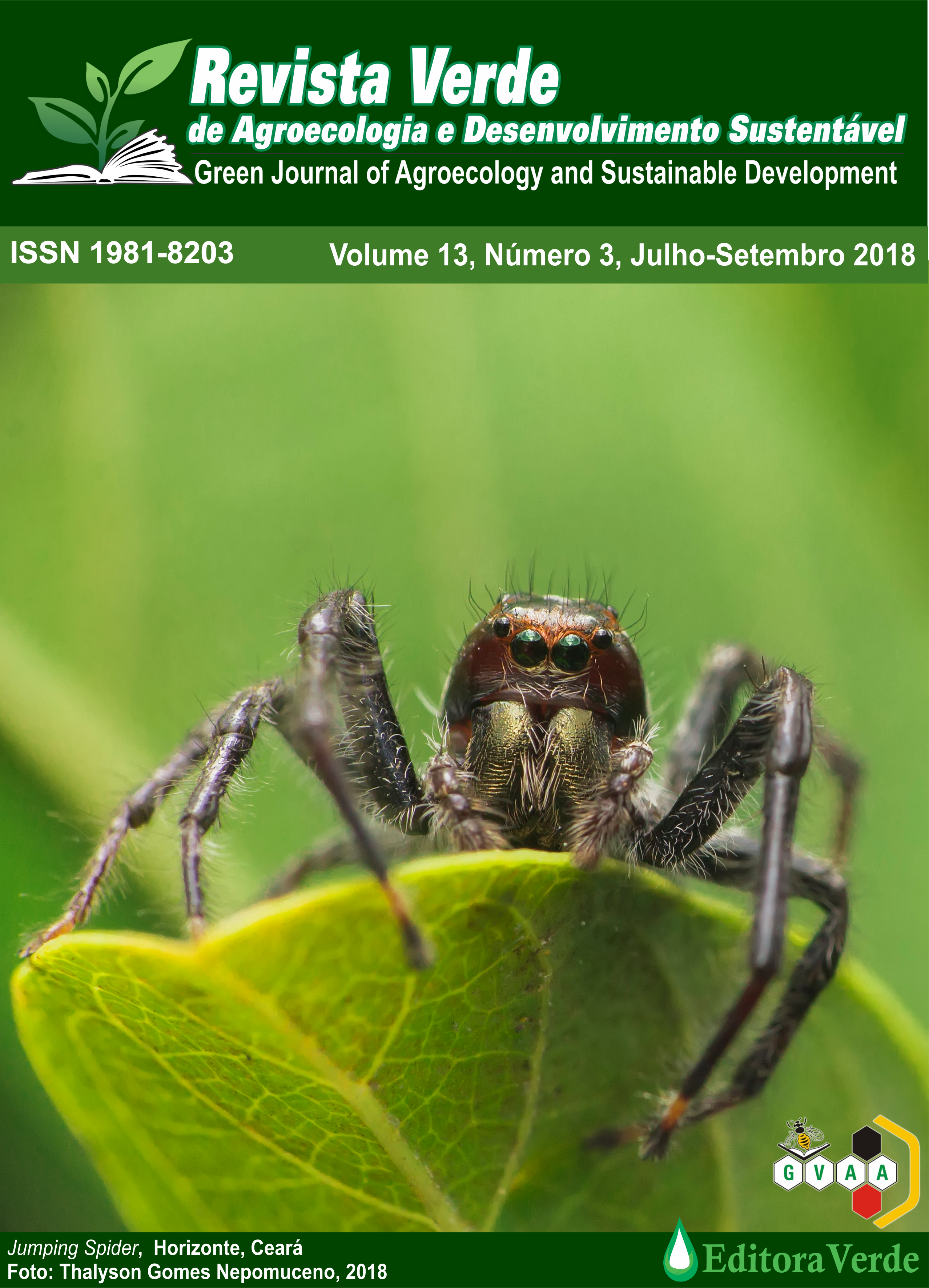Bees and melitophilous species of ciliary forest of the Salgadeira stream, municipality of Alcantil, Paraiba, Brazil
DOI:
https://doi.org/10.18378/rvads.v13i3.5788Keywords:
Bee – plant interaction. Caatinga. Environmental indicators.Abstract
The Caatinga is located in the intertropical environment and has a complex xerophytic vegetation cover. Its degradation is contributing to the disappearance of species of plants and animals. As bees, participate in the process of pollination, also fits this problem. This study evaluated the richness and abundance of bees in two areas of the Caatinga riparian forest in the preserved and degraded (salinized) stretches of the Salgadeira stream. The selected areas were collected in the period of May and June of 2016. Each sample is characterized by twelve collections, in two consecutive days between 06:00 and 15:00 h. The volume was calculated in 491 individuals from 34 plant species of five families. The composition of apifauna was recorded by 52 individuals of 12 species in the part of the preserved ciliary forest, whereas a degraded area occurred, only one species, with 4 individuals. Apis mellifera and Trigona spinipes accounted for 2/3 of all samples, mainly from the degraded area. It is recorded the presence of Cebulus longipalpis, an oligolética species, which is a dependence with Varronia leucocephala, being this genus the only endemic of the Caatinga. From the results considered, the bees from preserved environments are threatened by the degradation with deforestation of the vegetation cover in the area.Downloads
References
AESA, 2009. Relatório anual sobre a situação dos recursos hídricos no Estado da Paraíba.
AGUIAR, C. M. L.; ZANELLA, F. C. V. Estrutura da comunidade de abelhas (Hymenoptera: Apoidea: Apiformis) de uma área na margem do domínio da Caatinga (Itatim, BA). Neotrop. Entomol. Londrina, v. 34, n.1, 2005
ALVES-DOS-SANTOS, I.; SILVA, C. I.; PINHEIRO, M.; KLEINERT, A. Quando um visitante floral é um polinizador?. Rodriguésia, v. 67, n. 2, p. 295-307, 2016.
ALVES, A. P. A.; PEREIRA, T.M. S.; MARQUES, A. L.; MOURA, D. C. MELO, J. I. M. Sucessão ecológica em área de exploração mineral do semiárido paraibano (Brasil). ACTA Acta Geográfica, Boa Vista, v.12, n.29, 2018. p. 75-93, 2018.
ANDRADE, G. O. de. O Rio Paraíba do Norte. João Pessoa: Editora Universitária/UFPB. Conselho Estadual de Cultura, 1997, 166p.
ARAUJO, L. E. A.; SILVA, D. Influência da Variabilidade Climática sobre a Distribuição Espaço-Temporal da Precipitação na Região do Baixo Paraíba (PB). Caminhos de Geografia Uberlândia v. 12, n. 37, p. 289 – 304, 2013.
CARVALHO, C. P. de O. ANDRADE, M. C. A Economia Política do Nordeste. Rev. Econ. NE, Fortaleza, v. 45, n. 2, p. 6-16, abril/jun., 2014.
CORREIA, F. C. S.; FRANCISCO, R. S.; PERUQUETTI, R. C. Palinologia e a interação planta-abelha: revisão de literatura. Arq. Ciênc. Vet. Zool. UNIPAR, Umuarama, v. 20, n. 4, p. 247-251, 2017.
FARIAS, R. C.; LACERDA, A. V.; GOMES, A. C.; BARBOSA, F. M.; DORNELAS, C. S. M.; Riqueza florística em uma área ciliar de caatinga no Cariri Ocidental da Paraíba, Brasil. Revista Brasileira de Gestão Ambiental e Sustentabilidade, 2017.
FREIRE, N. C. F.; MOURA, D. C.; SILVA, J. B. DA; MOURA, A. S. S. DE; MELO, J. I. M. DE; PACHECO, A. P. Atlas da Caatinga: o único bioma exclusivamente brasileiro. Recife: Fundação Joaquim Nabuco, Editora Massangana, p. 200, 2018.
GIANNINI, T. C.; MAIA-SILVA, C.; ACOSTA, A. L.; JAFFÉ, R.; CARVALHO, A. T.; MARTINS, C. F.; ZANELLA, F. C. V.; CARVALHO, C. A. L.; HRNCIR, M.; SARAIVA, A. M. J.; SIQUEIRA, O.; IMPERATRIZ-FONSECA, V. L. Protecting a managed bee pollinator against climate change: strategies for an area with extreme climatic conditions and socioeconomic vulnerability. Apidologie,v. 48, p. 84–794, 2017.
GOMES, F. S.; GUEDES, M. L. da S.; VALADÃO, R. de M.; PRATES, A. R. S.; COSTA, M. A. de A. Florística e estrutura de um trecho e mata Ciliar do Rio Carinhanha, Feira da Mata, Bahia, Brasil. Revista Biotemas, v. 27, n. 3, 2014.
INPE, Instituto Nacional de Pesquisas Espaciais. Boletim Meteorológico, v. 3, n. 25, 2014.
MARTINS, C. F. Comunidade de abelhas (Hyminoptera, Apoidea) da caatinga e do cerrado com elementos de campo rupestre do estado da Bahia, Brasil. Rev. Nordestina de Biologia, v.9, n. 2., p. 225-257, 1994.
MILET-PINHEIRO, P.; SCHLINDWEIN, C. Comunidade de abelhas (Hymenoptera, Apoidea) e plantas em uma área do Agreste pernambucano, Brasil. Revista Brasileira de Entomologia, v. 52, n.4, p. 625-636, 2008.
MILET-PINHEIRO, P.; SCHLINDWEIN, C. Cordia leucocephala Mutual reproductive dependence of distylic (Cordiaceae) Ceblurgus longipalpis and oligolectic (Halictidae, Rophitinae) in the Caatinga. Annals of Botany: 106 17 – 27, 2010.
MOURA, D. C.; SCHILINDWEIN, C. mata Ciliar do Rio São Francisco como biocor, Apidae) de Florestas Tropicais Úmidas. Neotropical Entomology, v. 38, p. 281-284, 2009.
PEREIRA JÚNIOR, L. R; ANDRADE, A. P. de; ARAÚJO, K. D. Composição florística e fitossociológica de um fragmento de caatinga em Monteiro-PB. HOLOS. Ano 28, v. 6. p.73-87, 2012.
ROUBIK, D. W. Ecology and natural history of tropical bees. Cambridge: Cambridge University Press, p. 514,1989.
SCHLINDWEIN, C. Panurginae (Hymenoptera, Andrenidae) in Northeastern Brazil. In: Melo, G. A. R., Alves - dos - Santos, I. Apoidea Neotropica: Homenagem aos 90 Anos de Jesus Santiago Moure. Criciúma: Editora da Editora da Universidade do Extremo Sul Catarinense, p. 217 – 222, 2003.
SILVA, F. G.; SILVA, R. H. da.; ARAÚJO, R. M. de; LUCENA, M. de F. de A.; SOUSA, J. M. de. Levantamento florístico de um trecho de mata ciliar na mesorregião do Sertão Paraibano. Revista Brasileira de Biociências, Porto Alegre, V. 13, n. 4, 2015.
SILVEIRA, F. A.; MELO, G. A. R.; ALMEIDA, E. A. B. Abelhas brasileiras: Sistemática e identificação. Belo Horizonte: Edição dos autores, p. 253, 2002.
SOUZA, B. I.; ARTIGAS, R. C.; LIMA, E. R. V.; Caatinga e desertificação. Revista Mercator. v. 14, n. 1. UFCE: Fortaleza, p.131-150, 2015.















